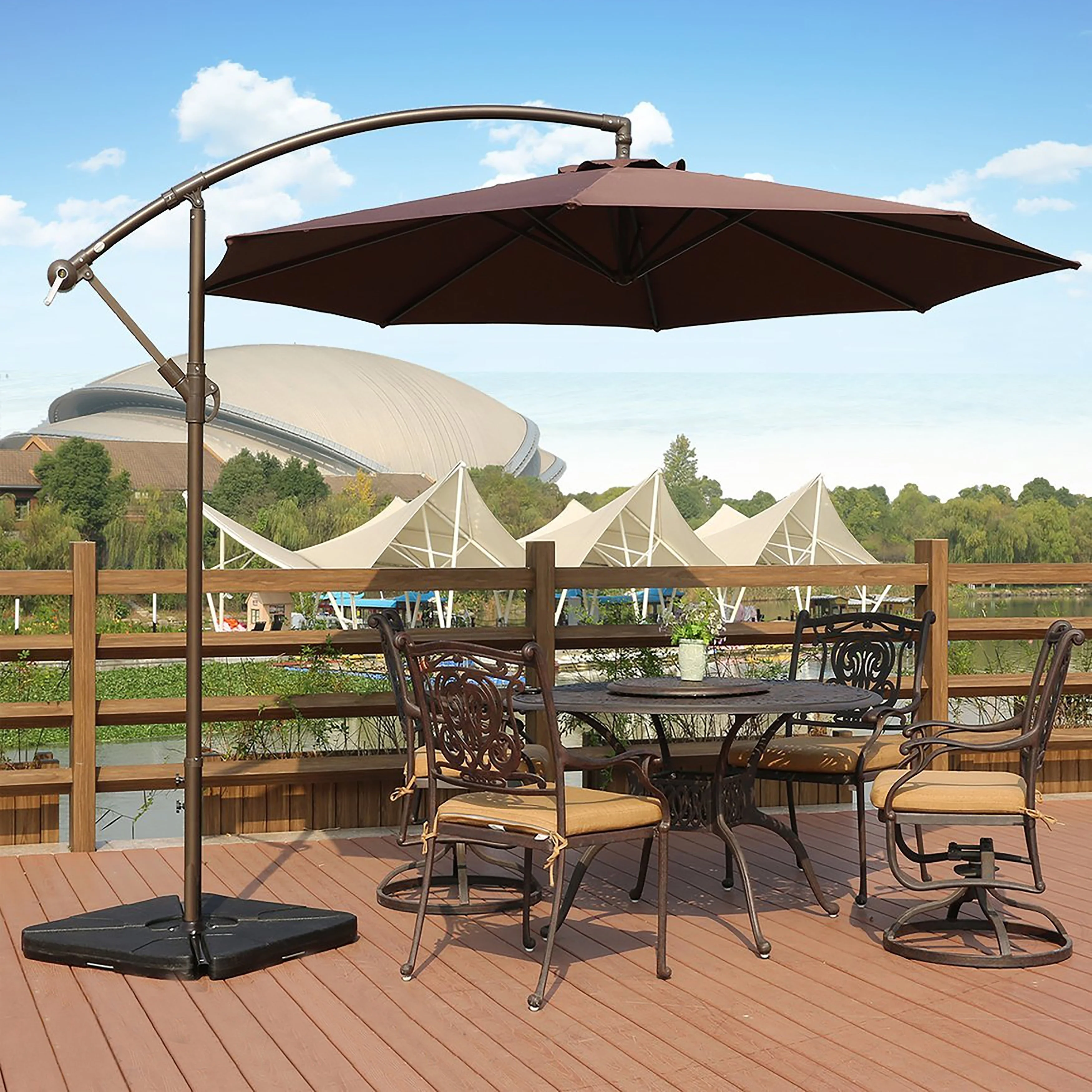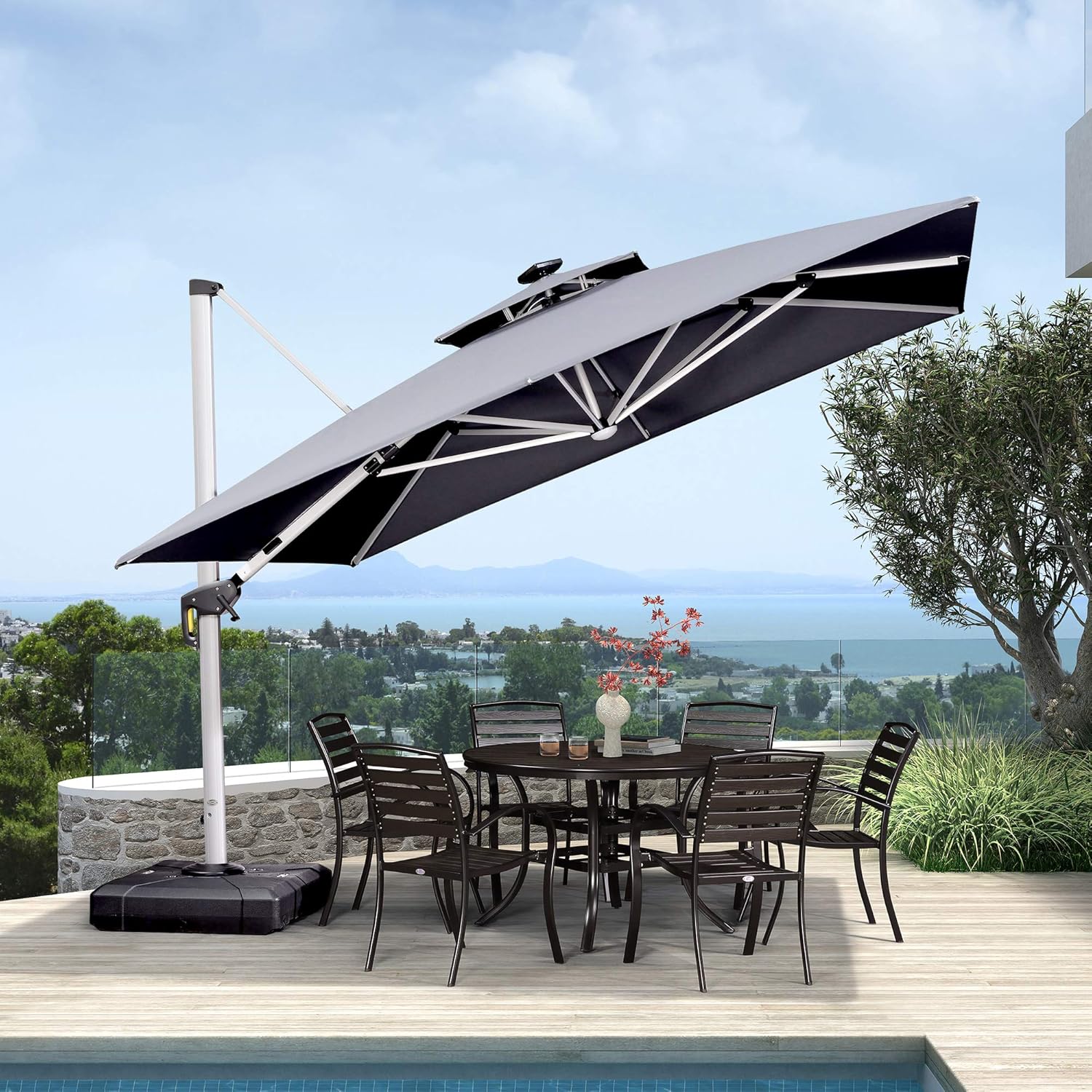
Imagine a sunny weekend, you are about to enjoy a cool drink on your patio, and suddenly, the sun is scorching and you have to find a place to escape the heat. At this point, you realize that it is time to add a patio umbrella to your outdoor space! But the question is, with so many options on the market, how can you choose the perfect patio umbrella for your space?
Don’t worry, this article will walk you through all the important factors to consider when choosing a patio umbrella.
Patio Umbrellas are Popular, You Should Go Out and Buy One, Right?
Today’s outdoor lifestyle has gone beyond simple barbecues or party activities. Whether it is a patio, garden or poolside, the right umbrella can not only provide shade, but also enhance the beauty of the entire space. Whether it is enjoying a leisurely afternoon alone or entertaining friends, outdoor patio umbrellas have become an important element to create a comfortable outdoor environment. It not only provides you with the necessary shade, but also adds a different kind of beauty to the entire patio.
You may ask: "Is it really necessary to buy a patio umbrella?" The answer is yes. If your outdoor space is always exposed to the sun, long-term exposure is not only unbearable, but also harmful to furniture. A suitable patio umbrella can effectively solve this problem, allowing you to enjoy the good time outdoors even in the hot summer.
However, choosing a patio umbrella is not as simple as buying a cup of coffee. There are umbrellas of various shapes, sizes, materials and functions on the market. Which one is best for your needs? It takes a little time and effort to make the right choice.
What Is the Importance of Patio Umbrella Size?
When choosing a patio umbrella, size is definitely the first consideration. There is nothing more disappointing than finding out that the umbrella is too big or too small after buying it home. The size of the patio umbrella affects not only its functionality, but also the aesthetics of the entire space. If the umbrella you choose is too small, it may not provide shade for all seats; if the umbrella is too large, it will appear cramped and even affect your freedom of movement.
When choosing the size of the umbrella, it is key to consider the area covered by the umbrella. Generally speaking, you can determine the size of the umbrella based on the number of seats and the size of the table. Remember, this choice is not only for shade, but also related to the layout and visual effect of the entire patio.
How to Choose the Right Umbrella Size?
Generally speaking, patio umbrellas range in size from 6 feet to 13 feet. When choosing the size of an umbrella, you should consider the area you need to cover. The diameter of the umbrella should be at least 2-3 feet wider than the area you want to cover. For example, if your table is 4 feet in diameter, you need to choose an umbrella that is at least 8 feet in diameter to ensure adequate shade.
When choosing the size, consider not only the shade, but also the wind. Large umbrellas, while providing more shade, may not be stable enough in strong winds. Therefore, if you are in an area with strong winds, a slightly smaller but more stable umbrella may be a better choice.

Measure Your Outdoor Living Space, How to Measure it?
After determining the basic size of the umbrella, the next step is to measure your outdoor space. Accurate measurements can help you avoid buying an umbrella that is not suitable, saving time and money. So, how to measure your outdoor space correctly?
First, you need to determine the overall size and shape of your patio. Are there any irregular corners or obstacles? These will affect the placement and size of the umbrella. Next, measure your outdoor furniture. For example, if you have a round table, you may need to consider a wider area of shade, while if it is a rectangular table, you need to consider whether the width of the umbrella is sufficient. The most important thing is to take into account the flow of people when measuring. Even if the umbrella is large enough, you need to make sure that people can move around without being tripped or restricted by the umbrella pole. Therefore, try to leave enough space for passage when measuring.
Step 1: Determine the coverage of the umbrella
First, imagine the area you want the umbrella to cover. Is it the entire patio, or just the dining table or lounge chairs? Take out the tape measure, measure the length and width of the area you want to cover, and write it down.
Step 2: Consider the mobility of the umbrella
You may not want the umbrella to be fixed in one position all the time, so it is also important to consider the mobility of the umbrella. Leave enough space for the umbrella to move between different positions to ensure that you can provide shade at different times.
Step 3: Check for obstacles
When measuring, also pay attention to surrounding obstacles such as walls, trees, or other furniture. These obstacles may affect the space where the umbrella can be deployed and used, and considering these factors in advance can avoid trouble later.
Determine the Ideal Height and Width of the Umbrella
The height and width of the patio umbrella not only affect the sunshade effect, but also directly relate to the comfort and aesthetics of use. When choosing, we need to consider several key factors: the height of the umbrella, the diameter of the umbrella, and the adjustable function of the umbrella.
Height selection
The first is the height of the umbrella. Generally speaking, the lowest point of the umbrella (usually the edge of the umbrella) should be about 1.8 meters (7 to 9 feet) above the head to ensure that people do not feel oppressive when moving under the umbrella. However, an umbrella pole that is too high will also cause the umbrella to become unstable in the wind. Therefore, choosing a suitable height is very important. In addition, an umbrella with the right height can prevent the sun from shining directly on you when it shines at a low angle in the morning or evening.
Width considerations
In addition to the diameter of the umbrella, the height and width of the umbrella are also crucial, that is, the diameter of the umbrella. A perfect patio umbrella can not only provide enough shade, but also be in harmony with the surrounding environment in terms of height and width. This size depends on your sunshade needs. If you only want to provide shade for a small area, such as a love seat, then a small patio umbrella with a diameter of 2 meters may be enough. But if you need to shade an entire outdoor dining table or a wide terrace, it would be ideal to choose an umbrella of 4 meters or even larger. When choosing the width, make sure that the edge of the umbrella does not touch the table, chairs or other objects, which would affect the comfort.
Adjustable function
If you want the umbrella to provide different shade angles at different times, it would be a good choice to choose an umbrella with adjustable height or angle. Such umbrellas are usually equipped with a hand-crank or button system for easy use.

Choose the Right Tilt Mechanism for Patio Umbrellas to Get the Best Sun Protection
Imagine that the sun rises from the east and does not set in the west until the evening. During this long time, the angle of the sun keeps changing, so a patio umbrella with a fixed angle alone may not be able to provide effective sun protection all day long. At this time, it is particularly important to choose a patio umbrella with a tilt function.
Umbrellas with a tilt function can be adjusted according to the angle of the sun, which not only provides the best sun protection at different times, but also provides you with more convenience. Whether it is sunbathing in the morning or relaxing in the evening, you can easily enjoy outdoor life all day long with just a slight turn.
What Are the Types of Patio Umbrella Tilt Mechanisms?
Manual Tilt Mechanisms
This mechanism is usually the simplest, as you can adjust the angle of the umbrella by simply turning a handle. Manual tilt mechanisms are suitable for those who want to adjust the angle of the umbrella quickly and easily.
Push-Button Tilt Mechanisms
Push-button mechanisms require you to press a button to adjust the angle of the umbrella. Although this mechanism is slightly more complicated, it provides more precise angle control.
Automatic Tilt Mechanisms
Automatic tilt mechanisms are the most convenient option, and they can automatically adjust the angle of the umbrella at the press of a button or a remote control, making them perfect for those who seek convenience.
How to Choose the Right Tilt Mechanism?
Choosing the right tilt mechanism depends on your personal needs and budget. If you need to adjust the angle of the umbrella frequently, automatic or manual tilt mechanisms will be more convenient. If you are on a limited budget, push-button mechanisms are also a good choice.
Considerations for Placing the Umbrella
Once you have chosen the umbrella, the next step is where to place it. Although it may seem simple, if it is not placed properly, it may greatly reduce the original wonderful patio experience.
First, you need to choose a location that can maximize the sunshade effect. Generally speaking, placing it in the center of the dining table or directly above the chairs is the best choice. For example, if your patio furniture is arranged around a table, then placing the umbrella in the center of the table is the most common choice. Center placement provides even shade for all seats, and the base does not take up extra space. For some outdoor spaces with irregular layouts, placing the umbrella to the side is a good option. This allows the umbrella to be placed in a place that does not take up the center position while still providing shade for a certain area. You can also consider moving the umbrella to a corner of the patio if the sun is more direct during certain hours.
Second, pay attention to the coverage of the umbrella. Make sure the umbrella effectively covers all furniture and areas that need shade. If the umbrella's coverage is too small, you may want to consider switching to a larger umbrella or adding another umbrella to supplement.
In addition, if you want to use the umbrella for shade at different times, it is important to choose an umbrella base that is movable or has a wheeled umbrella stand. This allows you to flexibly adjust the position of the umbrella according to the angle of the sun to achieve the best shade.
Match the Umbrella Size to the Table and Seating Area
Here is a simple rule: the larger the table, the larger the umbrella should be. The reason is simple. If the size of the umbrella is not enough to cover the entire table and seating area, some areas may still be exposed to the sun, which loses the functionality of the umbrella.
Combination of large tables and chairs with large umbrellas
If your outdoor space has a large dining table and multiple chairs, choosing an umbrella with a diameter between 10 and 13 feet will be the best choice. This umbrella will provide enough shade to cover the entire seating area so that everyone can enjoy a comfortable dining experience. For example, if you have a six-seater round dining table on your patio, you will need at least a 3-meter (about 10 feet) diameter patio umbrella to ensure that the entire table is effectively shaded. For a larger rectangular dining table, you may need a 4-meter (about 13 feet) or larger umbrella to cover all seating areas.
Small table and chairs with small umbrellas
For small patios or balconies, a small table and chairs with a small umbrella is more coordinated. Choosing an umbrella with a diameter between 6 and 8 feet can provide appropriate shade for your small space without appearing too bloated.
In addition to the common round umbrellas, there are square, rectangular and even octagonal umbrellas on the market. These umbrellas have unique shapes that can better adapt to different shapes of tables and seating areas, providing more uniform shade.
Of course, in addition to functionality, the size of the umbrella should also be coordinated with the proportions of the table and seats. If the umbrella is too large, it may make the table look too small; if the umbrella is too small, it will not provide sufficient shade. Therefore, it is particularly important to choose an umbrella size that matches the table and seats.

Patio Umbrella Base Considerations and Weight Requirements
Last but not least, the patio umbrella base. Don't underestimate this small base. No matter which type of patio umbrella you choose, the stability of the umbrella base is a key factor in determining whether the umbrella can be used safely. Especially in windy areas, the weight and material selection of the umbrella base directly affect the stability of the umbrella.
Umbrella Base Weight Requirements
First, the weight of the base must be sufficient. A lighter base may not be able to support it in strong winds or heavy rain. The weight of the umbrella causes the umbrella to topple or move. The weight of the umbrella base should be determined according to the size of the umbrella and the local wind conditions. Generally speaking, the larger the diameter of the umbrella, the heavier the weight of the base should be. For example, for an umbrella with a diameter between 9 and 11 feet, the weight of the base should be at least 50 to 70 pounds. For larger umbrellas, a heavier base is required, and even an adjustable base with water or sand can be selected.
Choice of base shape and material
Secondly, the shape and material of the base are also factors to consider. A wide and stable base can better disperse the weight of the umbrella and increase stability. The materials of the umbrella base vary, and the common ones are plastic, metal, and concrete. The plastic base is light, but may not be stable enough in strong winds; the metal base is durable but easy to Rust; the concrete base is heavy but very stable. Choosing the right material for your needs can ensure the safe use of the umbrella.
Base placement
When installing the umbrella base, make sure it is placed on flat and solid ground. Avoid placing the umbrella base on uneven or soft ground, which will affect the stability of the umbrella. In addition, check the fixings of the umbrella base to ensure that the umbrella will not be blown over in windy weather.
Choosing the perfect patio umbrella is not only about sun protection, but also about improving the comfort and beauty of the entire outdoor space. From the size, material, tilt mechanism to the choice of the umbrella base, every aspect needs to be carefully considered. With the above steps, you can find a patio umbrella that is both beautiful and practical, adding more fun to your outdoor life.
So, don't hesitate! Hurry up and grab a tape measure, measure your outdoor space, and start choosing the perfect umbrella for your patio!

